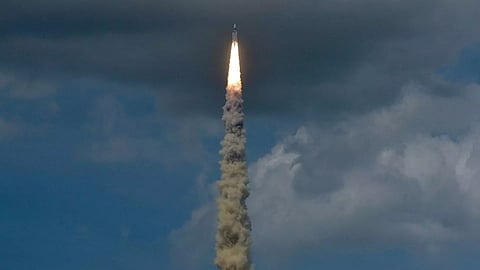

India’s third lunar mission, Chandrayaan-3 was successfully launched onboard a Launch Vehicle Mark-3 (LVM-3) rocket from the Satish Dhawan Space Centre in Sriharikota last week. The launch marks India’s second attempt at soft-landing robotic instruments on the surface of the moon after the previous attempt, Chandrayaan-2 failed four years ago. As of date, only three nations — the US, Russia, and China have successfully executed soft landings on the moon.
This time around, the mission has been designed better to withstand the challenges of a robotic moon landing near the south pole, as per S Somnath, the ISRO chairman. The objective of the Chandrayaan-3 mission is to develop and demonstrate new technologies necessary for inter-planetary missions. If it succeeds, the mission would provide a major fillip for the space agency which is now preparing for another daunting programme — the manned Gaganyaan mission to space.
Today, lunar missions have huge implications on earthly geopolitics. Even as Chandrayaan-3 moves towards its date with destiny, around 11 deep space missions are being planned by various nations, with the biggest among them being the Artemis programme — the US led initiative to pack off humans to the moon permanently. Just last month, India became the 27th signatory to the Artemis Accords — a set of non-binding guidelines that underscore the programme.
This plan envisages the creation of a base on the lunar surface, multiple spacecraft to transport cargo and humans, an orbiting space station, as well as satellites to aid navigation and communication. The US isn’t alone in such interstellar ambitions as scientists globally are mulling over the feasibility of using the moon as an outpost, much like missions in Antarctica. The waning role of the International Space Station has also been highlighted and several nations are keen on filling that gap and constructing permanent structures on the lunar surface.
China is also blazing ahead with space programmes of its own. In collaboration with Russia, it has initiated the International Lunar Research Station (ILRS), a planned lunar base currently managed by Roscosmos and the China National Space Administration (CNSA). In 2021, China had launched the first module of its space station Tiangong, which is being constructed in low Earth orbit. For India, space and satellite exploration have culminated in technological leaps in areas of communication, renewable energy, defence, agriculture. The country is known for its frugal ingenuity — the Chandrayaan-2 mission launched in 2013 cost Rs 470 crore while the Hollywood sci-fi blockbuster Gravity had a budget exceeded Rs 644 crore ($100 million).
With Chandrayaan-3, India hopes to do some heavy lifting. But it will require a significant hike in its annual budget, which is estimated to be Rs 12,500 cr this year. The nation must drop its hesitation on collaborating with space agencies of other nations —as there is immense business value to be derived from the manufacturing and launch of satellites.
In 2020, the country had opened up its space sector, with the introduction of the commercial arm of ISRO — NewSpace India Ltd. It must now give a boost to the private sector for increasing its participation in programmes such as the Artemis. India also released a much-needed space policy recently, but we must have legislation to prevent the potential weaponisation of space, and we need to offer peaceful space programmes a long leash.